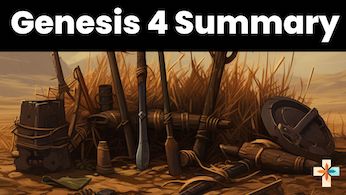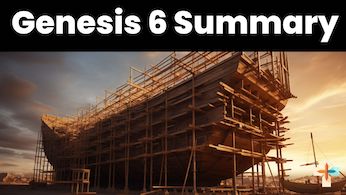Genesis 5 Summary Overview
Genesis 5 presents the genealogy of Adam’s descendants through the line of Seth, offering a glimpse into the lives of the antediluvian patriarchs who lived before the Great Flood. This chapter emphasizes the continuity of God’s promise despite the prevalence of sin and provides a historical link between Adam and Noah, the central figure in the upcoming flood narrative. By examining Genesis 5, we gain insights into the themes of longevity, the consequences of sin, and the unfolding of God’s redemptive plan.
Genesis 5 Summary Outline
I. The Genealogy of Adam (Genesis 5:1-32):
- Reiteration of humanity created in God’s image and likeness.
- Genealogy traces the lineage of Adam through Seth.
- Lists ten generations, including patriarchs’ names, ages, and lifespans.
II. The Longevity of the Antediluvian Patriarchs:
- Extraordinary lifespans of the patriarchs.
- Methuselah as the oldest recorded individual, living for 969 years.
- Interpretations vary from literal to symbolic.
III. The Persistence of Death:
- Despite long lifespans, death remains a constant presence.
- Each patriarch’s entry ends with “and he died.”
- Emphasizes consequences of sin and human mortality.
IV. The Exception of Enoch (Genesis 5:21-24):
- Enoch stands out in the genealogy.
- Enoch “walked with God” for 300 years.
- God takes Enoch away, avoiding death.
V. The Introduction of Noah (Genesis 5:28-32):
- Noah, born to Lamech, introduced.
- Lamech prophesies relief through Noah from the curse.
- Foreshadows Noah’s role in the upcoming flood narrative.
Conclusion:
- Genesis 5 bridges early events with the impending flood judgment.
- Highlights consequences of sin and hope of redemption.
- Enoch’s exceptional life demonstrates rewards for faithfulness.
- Introduction of Noah sets stage for God’s redemptive plan.
- Reflection on Genesis 5 deepens understanding of God’s promise and faithfulness.
I. The Genealogy of Adam (Genesis 5:1-32)
The chapter begins by reiterating the creation of humanity in God’s image and likeness, emphasizing the divine origin and nature of humanity (5:1-2). The genealogy that follows traces the lineage of Adam through Seth, listing a total of ten generations (5:3-32). The genealogy includes the names of the patriarchs, the ages at which they fathered their sons, and their total lifespans.
II. The Longevity of the Antediluvian Patriarchs
A striking feature of this genealogy is the extraordinary lifespans of the patriarchs, many of whom lived for centuries. Methuselah, the oldest recorded individual, lived for 969 years (5:27). This longevity has been the subject of much speculation and debate, with interpretations ranging from literal to symbolic. Regardless of the explanation, the long lives of the patriarchs serve to emphasize the contrast between the pre-Flood world and the post-Flood world, where lifespans gradually decrease.
III. The Persistence of Death
Despite the extended lifespans of the antediluvian patriarchs, death remains a constant presence in the genealogy. Each patriarch’s entry ends with the phrase “and he died” (e.g., 5:5, 8, 11), serving as a stark reminder of the consequences of sin introduced in Genesis 3. This recurring theme underscores the pervasive nature of sin and the reality of human mortality.
IV. The Exception of Enoch (Genesis 5:21-24)
Enoch, the seventh generation from Adam, stands out as an exception in the genealogy. Enoch’s close relationship with God is highlighted, as he “walked with God” for 300 years (5:22). Enoch’s life is unique in that he does not experience death; instead, God takes him away (5:24). Enoch’s exceptional life serves as a testimony to the rewards of faithfulness and the hope of life beyond death for those who walk closely with God.
V. The Introduction of Noah (Genesis 5:28-32)
The genealogy concludes with the introduction of Noah, who is born to Lamech (5:28-29). Lamech prophesies that Noah will bring relief from the toil and hardship resulting from the curse placed on the ground in Genesis 3 (5:29). This prophecy foreshadows the pivotal role that Noah will play in the upcoming flood narrative and the continuation of God’s redemptive plan.
Conclusion:
Genesis 5 serves as a bridge between the early events of creation and the impending judgment of the Great Flood. Through the genealogy of Adam’s descendants and the extraordinary lifespans of the antediluvian patriarchs, this chapter highlights the consequences of sin and the hope of redemption. Enoch’s exceptional life provides a glimpse of the rewards for faithfulness, while the introduction of Noah sets the stage for the next phase of God’s redemptive plan. By reflecting on the themes and lessons of Genesis 5, we gain a deeper understanding of the continuity of God’s promise and the importance of faithfulness in our own lives.
superduper

Where are you on your Spiritual Journey? Discover where you are on your Spiritual Journey in just 60 seconds and find out your next steps.
Take Your Spiritual Journey Quiz

